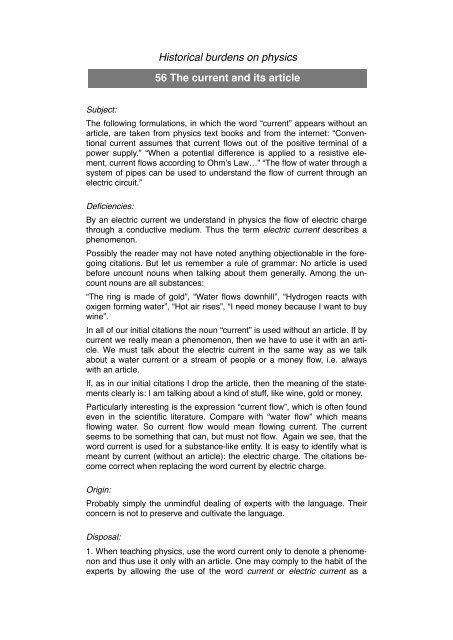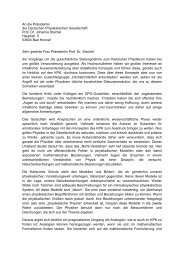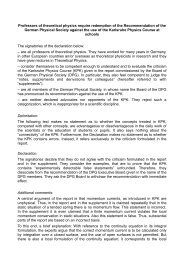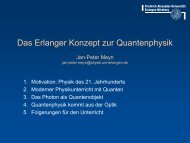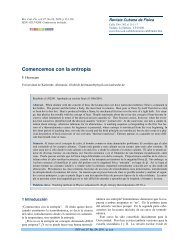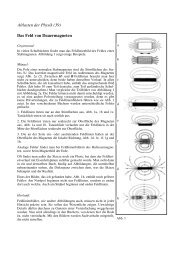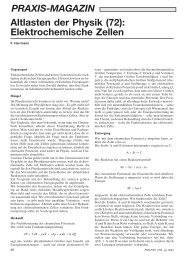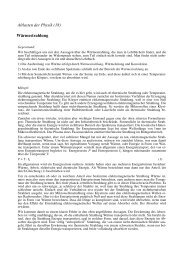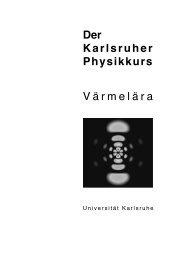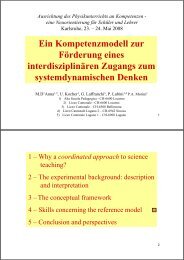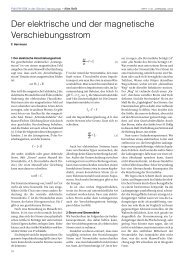Historical burdens on physics 56 The current and its article
Historical burdens on physics 56 The current and its article
Historical burdens on physics 56 The current and its article
Create successful ePaper yourself
Turn your PDF publications into a flip-book with our unique Google optimized e-Paper software.
<str<strong>on</strong>g>Historical</str<strong>on</strong>g> <str<strong>on</strong>g>burdens</str<strong>on</strong>g> <strong>on</strong> <strong>physics</strong><br />
<strong>56</strong> <strong>The</strong> <strong>current</strong> <strong>and</strong> <strong>its</strong> <strong>article</strong><br />
Subject:<br />
<strong>The</strong> following formulati<strong>on</strong>s, in which the word “<strong>current</strong>” appears without an<br />
<strong>article</strong>, are taken from <strong>physics</strong> text books <strong>and</strong> from the internet: “C<strong>on</strong>venti<strong>on</strong>al<br />
<strong>current</strong> assumes that <strong>current</strong> flows out of the positive terminal of a<br />
power supply.” “When a potential difference is applied to a resistive element,<br />
<strong>current</strong> flows according to Ohm’s Law…” “<strong>The</strong> flow of water through a<br />
system of pipes can be used to underst<strong>and</strong> the flow of <strong>current</strong> through an<br />
electric circuit.”<br />
Deficiencies:<br />
By an electric <strong>current</strong> we underst<strong>and</strong> in <strong>physics</strong> the flow of electric charge<br />
through a c<strong>on</strong>ductive medium. Thus the term electric <strong>current</strong> describes a<br />
phenomen<strong>on</strong>.<br />
Possibly the reader may not have noted anything objecti<strong>on</strong>able in the foregoing<br />
citati<strong>on</strong>s. But let us remember a rule of grammar: No <strong>article</strong> is used<br />
before uncount nouns when talking about them generally. Am<strong>on</strong>g the uncount<br />
nouns are all substances:<br />
“<strong>The</strong> ring is made of gold”, “Water flows downhill”, “Hydrogen reacts with<br />
oxigen forming water”, “Hot air rises”, “I need m<strong>on</strong>ey because I want to buy<br />
wine”.<br />
In all of our initial citati<strong>on</strong>s the noun “<strong>current</strong>” is used without an <strong>article</strong>. If by<br />
<strong>current</strong> we really mean a phenomen<strong>on</strong>, then we have to use it with an <strong>article</strong>.<br />
We must talk about the electric <strong>current</strong> in the same way as we talk<br />
about a water <strong>current</strong> or a stream of people or a m<strong>on</strong>ey flow, i.e. always<br />
with an <strong>article</strong>.<br />
If, as in our initial citati<strong>on</strong>s I drop the <strong>article</strong>, then the meaning of the statements<br />
clearly is: I am talking about a kind of stuff, like wine, gold or m<strong>on</strong>ey.<br />
Particularly interesting is the expressi<strong>on</strong> “<strong>current</strong> flow”, which is often found<br />
even in the scientific literature. Compare with “water flow” which means<br />
flowing water. So <strong>current</strong> flow would mean flowing <strong>current</strong>. <strong>The</strong> <strong>current</strong><br />
seems to be something that can, but must not flow. Again we see, that the<br />
word <strong>current</strong> is used for a substance-like entity. It is easy to identify what is<br />
meant by <strong>current</strong> (without an <strong>article</strong>): the electric charge. <strong>The</strong> citati<strong>on</strong>s become<br />
correct when replacing the word <strong>current</strong> by electric charge.<br />
Origin:<br />
Probably simply the unmindful dealing of experts with the language. <strong>The</strong>ir<br />
c<strong>on</strong>cern is not to preserve <strong>and</strong> cultivate the language.<br />
Disposal:<br />
1. When teaching <strong>physics</strong>, use the word <strong>current</strong> <strong>on</strong>ly to denote a phenomen<strong>on</strong><br />
<strong>and</strong> thus use it <strong>on</strong>ly with an <strong>article</strong>. One may comply to the habit of the<br />
experts by allowing the use of the word <strong>current</strong> or electric <strong>current</strong> as a
name for the quantity I, i.e. the electric <strong>current</strong> intensity. But if we do so we<br />
should tell to our students explicitly, that we use the same word with two<br />
different meanings: as a name of a phenomen<strong>on</strong> <strong>and</strong> as a name of a physical<br />
quantity.<br />
When we discuss anything that is flowing, tell to the student from the beginning<br />
what it is that flows: water, electric charge, energy… Never say that<br />
<strong>current</strong> is flowing.<br />
Friedrich Herrmann, Karlsruhe Institute of Technology


